St Bernard's Hospital
Uxbridge Road, Southall, Middlesex UB1 3EU
Medical dates:
Medical character:
Mental
The
Middlesex County Asylum in Hanwell was the first pauper lunatic asylum
built in England following the Madhouse Act of 1828, which allowed the
building of purpose-built asylums.
Building work began in 1829 on a 74-acre site - 44 acres of
which had been purchased from the Earl of Jersey.
The three-storey yellow brick building opened in May, 1831. Built to accommodate 500 patients, it was found out almost immediately it could only house 300. The building was enlarged in November of the same year. Two years later repairs were necessary. In fact, repairs, extensions and rebuilding were carried out in 1837. By 1841 90 staff were looking after 1302 patients.
In 1857 an attic floor was added to the original building and more extensions were added in 1879. By 1888 there were 1891 patients and the Asylum had become the largest in Europe.
The three-storey yellow brick building opened in May, 1831. Built to accommodate 500 patients, it was found out almost immediately it could only house 300. The building was enlarged in November of the same year. Two years later repairs were necessary. In fact, repairs, extensions and rebuilding were carried out in 1837. By 1841 90 staff were looking after 1302 patients.
In 1857 an attic floor was added to the original building and more extensions were added in 1879. By 1888 there were 1891 patients and the Asylum had become the largest in Europe.
It achieved great prominence in the field of psychiatric care because of two people, Dr William Ellis and Dr John Connolly.
Dr (later Sir) William Ellis, the first Medical Superintendent whose wife was the Matron, encouraged patients to use the skills and trades they had had before being admitted to the Asylum. This 'therapy of employment' benefitted both the Asylum and the patients themselves and was a precursor to occupational therapy. The extensive grounds were cultivated for produce. The Asylum became self-sufficient, with a farm, a laundry, a bakery and a brewery. (However, patient labour was somewhat abused by this system in the fight to reduce running costs). Local artisans - tailors, shoemakers - worked at the asylum. There was a gasworks and a fire brigade and even a burial ground for those patients whose relatives had not claimed their bodies. Water was taken from the nearby Grand Union Canal and the Asylum had its own dock for barges delivering coal and for taking away produce for sale.
Dr Ellis left in 1838 and his successor, a Dr J.G. Millingen, resigned shortly after his appointment following a disagreement with the governors.
Dr John Conolly became the third Medical Superintendent in 1839. He abolished mechanical restraints to control patients. This was a great success and encouraged other asylums also to do so. Padded cells, solitary confinement and sedatives were used instead.
In 1889 the newly formed LCC took over and the Asylum was renamed the London County Asylum, Hanwell.
By 1891 there were 139 members of staff caring for 1899 patients, 1138 of whom were female. Patients were looked after by members of their sex and there were two gatehouses at the entrance - one for males and one for females.
In 1918 the Asylum became known as the London County Mental Hospital.
In 1929 it was renamed Hanwell Mental Hospital.
In 1937 its name changed again, to St Bernard's Hospital, Southall.
During WW2 the Emergency Medical Services commandeered one ward for war casualties. The Hospital and grounds received some bomb damage and later the laundry was destroyed by a V1 flying bomb, which caused many casualties. A gatehouse was also damaged.
It joined the NHS in 1948 as part of the North West Metropolitan Region, with its own Hospital Management Committee.
By the 1960s the Hospital in its 74 acre site held 2200 patients.
In 1974, in one of the NHS reorganisations, it became part of the North West Thames Regional Health Area within the Ealing Health District.
The eastern part of the site, previously used as a recreational ground and cycle track was sold for redevelopment. A new District General Hospital - Ealing Hospital - was built on the land and opened in 1979.
St Bernard's Hospital was merged with the adjacent Ealing Hospital in 1980 and became the Psychiatric Unit. It was then known as the St Bernard's Wing of the Ealing Hospital. By this time it had 950 beds for psychiatric and psychogeriatric patients.
In 1992 the Ealing Hospital General Unit and Maternity Unit split off to form a new Trust and the St Bernard's Wing regained its previous name of St Bernard's Hospital. However, for some years after this it still found itself responsible for the site maintenance of its neighbour.
The Hospital underwent a major refurbishment in 1998. The exterior of the buildings still in use were cleaned, revealing the yellow colouring of the bricks.
Dr (later Sir) William Ellis, the first Medical Superintendent whose wife was the Matron, encouraged patients to use the skills and trades they had had before being admitted to the Asylum. This 'therapy of employment' benefitted both the Asylum and the patients themselves and was a precursor to occupational therapy. The extensive grounds were cultivated for produce. The Asylum became self-sufficient, with a farm, a laundry, a bakery and a brewery. (However, patient labour was somewhat abused by this system in the fight to reduce running costs). Local artisans - tailors, shoemakers - worked at the asylum. There was a gasworks and a fire brigade and even a burial ground for those patients whose relatives had not claimed their bodies. Water was taken from the nearby Grand Union Canal and the Asylum had its own dock for barges delivering coal and for taking away produce for sale.
Dr Ellis left in 1838 and his successor, a Dr J.G. Millingen, resigned shortly after his appointment following a disagreement with the governors.
Dr John Conolly became the third Medical Superintendent in 1839. He abolished mechanical restraints to control patients. This was a great success and encouraged other asylums also to do so. Padded cells, solitary confinement and sedatives were used instead.
In 1889 the newly formed LCC took over and the Asylum was renamed the London County Asylum, Hanwell.
By 1891 there were 139 members of staff caring for 1899 patients, 1138 of whom were female. Patients were looked after by members of their sex and there were two gatehouses at the entrance - one for males and one for females.
In 1918 the Asylum became known as the London County Mental Hospital.
In 1929 it was renamed Hanwell Mental Hospital.
In 1937 its name changed again, to St Bernard's Hospital, Southall.
During WW2 the Emergency Medical Services commandeered one ward for war casualties. The Hospital and grounds received some bomb damage and later the laundry was destroyed by a V1 flying bomb, which caused many casualties. A gatehouse was also damaged.
It joined the NHS in 1948 as part of the North West Metropolitan Region, with its own Hospital Management Committee.
By the 1960s the Hospital in its 74 acre site held 2200 patients.
In 1974, in one of the NHS reorganisations, it became part of the North West Thames Regional Health Area within the Ealing Health District.
The eastern part of the site, previously used as a recreational ground and cycle track was sold for redevelopment. A new District General Hospital - Ealing Hospital - was built on the land and opened in 1979.
St Bernard's Hospital was merged with the adjacent Ealing Hospital in 1980 and became the Psychiatric Unit. It was then known as the St Bernard's Wing of the Ealing Hospital. By this time it had 950 beds for psychiatric and psychogeriatric patients.
In 1992 the Ealing Hospital General Unit and Maternity Unit split off to form a new Trust and the St Bernard's Wing regained its previous name of St Bernard's Hospital. However, for some years after this it still found itself responsible for the site maintenance of its neighbour.
The Hospital underwent a major refurbishment in 1998. The exterior of the buildings still in use were cleaned, revealing the yellow colouring of the bricks.
Present status (May 2008)
The Hospital has split off from the Ealing Hospital. It now exists as an independent trust - part of the West London Mental Health (NHS) Trust. It has about 376 beds and continues to provide forensic and acute mental health treatment. The headquarters of the Trust are also located here.
Many of the Grade II listed buildings remain, including the chapel and the two gatehouses with porter's lodges. A long portion of the boundary wall survives along the canal
The Grade II listed ward blocks on the south side by the canal have been replaced by low-rise buildings with inward barbed wire fences.
The site of the burial grounds was used to build the Regional Secure Unit (RSU). Human remains were removed and reinterred by Cherished Land in a "Garden of Remembrance".
The women's section from Broadmoor Hospital transferred to the newly built £22m The Orchard in 2007 (the West London Mental Health Trust is also responsible for Broadmoor High Secure Hospital in Crowthorne, Berkshire). The Orchard is built on the site of the Asylum's orchard at the southwest corner.
Much of the Hospital land has been sold for redevelopment as private housing. The western block with its panopticon octagonal tower is now Osterley Views. Osterley Gardens is the block leading off to the west from it. The redeveloped site also contains new buildings.
The Hospital has split off from the Ealing Hospital. It now exists as an independent trust - part of the West London Mental Health (NHS) Trust. It has about 376 beds and continues to provide forensic and acute mental health treatment. The headquarters of the Trust are also located here.
Many of the Grade II listed buildings remain, including the chapel and the two gatehouses with porter's lodges. A long portion of the boundary wall survives along the canal
The Grade II listed ward blocks on the south side by the canal have been replaced by low-rise buildings with inward barbed wire fences.
The site of the burial grounds was used to build the Regional Secure Unit (RSU). Human remains were removed and reinterred by Cherished Land in a "Garden of Remembrance".
The women's section from Broadmoor Hospital transferred to the newly built £22m The Orchard in 2007 (the West London Mental Health Trust is also responsible for Broadmoor High Secure Hospital in Crowthorne, Berkshire). The Orchard is built on the site of the Asylum's orchard at the southwest corner.
Much of the Hospital land has been sold for redevelopment as private housing. The western block with its panopticon octagonal tower is now Osterley Views. Osterley Gardens is the block leading off to the west from it. The redeveloped site also contains new buildings.
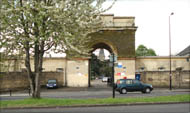
The formal entrance archway, made of gault clay brick, on the Uxbridge Road. The chapel can just be seen through the archway.
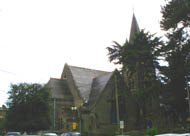
The chapel was built in 1881. An Open Day used to be held every year and historical artefacts displayed, but the Hospital Museum collection has now been dispersed.
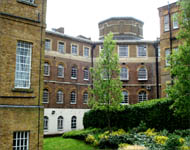
The male wing from the north, showing the supervisory central octagonal 'panopticon' and ventilation tower.
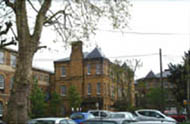
Part of the male wing with its sanitary towers.
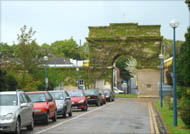
The entrance archway, seen from the interior of the site, is softened by vines growing on the upper section.
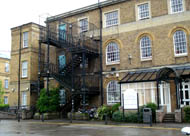
The original building can be distinguished by the semicircular brick arches at the tops of the windows. The third floor was added later.
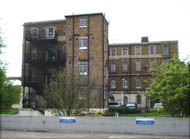
A ward block with squared windows, indicating it to be a later addition to the Asylum.
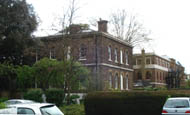
An original two-storey building, maybe the kitchens and offices
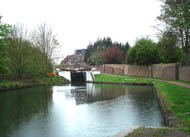
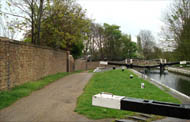
The Hanwell Flight of Locks on the Grand Union Canal runs alongside the high security wall
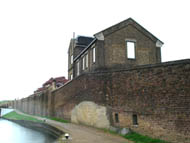
The former brewery
The extensive grounds contained a number of separate agricultural and industrial buildings.
The light coloured brick shows the filled-in entrance to the Asylum Lock. Coal for the Asylum boilers was delivered by barges, while surplus produce - fruit, vegetables and meat - was taken away to be sold.

The former brewery
The extensive grounds contained a number of separate agricultural and industrial buildings.
The light coloured brick shows the filled-in entrance to the Asylum Lock. Coal for the Asylum boilers was delivered by barges, while surplus produce - fruit, vegetables and meat - was taken away to be sold.
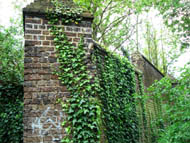
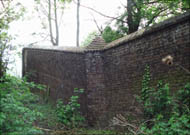
A high wall surrounds the entire site
On the death of Dr Burton in 1996 the brain bank was closed and subsequently transferred to WLMHT in 1997.
Runwell Hospital is partly still in use but it is proposed to close it in 2008.
Chaplin R, Peters S 2003 Executives have taken over the asylum: the fate of 71 psychiatric hospitals. Psychiatric Bulletin 27, 227-229.
http://pb.rcpsych.org
www.a2a.org.uk
www.british-history.ac.uk
www.countyasylums.com
www.ealing.gov.uk
www.en.wikipedia.org
www.europeanjourneys.org
www.geograph.org.uk
www.mazefind.co.uk
www.mdx.ac.uk
www.nationmaster.com
www.urban75.org
www.wlmht.nhs.uk
Return to home page